The highways in Macon have long stretches with fast-moving traffic, poor lighting and very few crosswalks. And they have a problem with pedestrian deaths.
“I found that Macon was leading the state in pedestrian deaths, and it bothered me,” said Macon-Bibb County Commissioner Elaine Lucas.
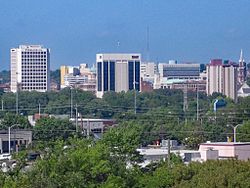
Lucas helped start the Macon-Bibb County’s Pedestrian Safety Review Board four years ago. The group consists of regular citizens, traffic engineers, public health and education officials, and the Bibb sheriff’s office.
“Macon should not lead the state, and be way up there in the nation for pedestrian deaths, we just shouldn’t be,” she said. “It’s an important health issue, public health issue, public safety issue, and one that we are finding that we can address.”
It’s still a problem. Pedestrian deaths last year in Macon/Bibb County reached at least 14, the highest total in at least seven years. Three deaths occurred over just one weekend.
The state’s statistics are equally troubling. The Governors Highway Safety Association (GHSA), a national nonprofit that represents state and territorial safety offices, recently reported that Georgia had 133 pedestrian deaths from January through June last year, up from 101 during the same period the previous year. Its 2018 total trailed only California, Florida and Texas, the three most populous states in the country.
And the national trend is grim as well. GHSA estimates the nationwide number of pedestrians killed in motor vehicle crashes in 2018 was 6,227, an increase of 4 percent from 2017. This projection would be the largest annual number of pedestrian fatalities in the nation since 1990.
So many factors to deal with
What’s behind these increases? GHSA cites factors that include increased exposure; unfriendly infrastructure; unsafe driving; and an increased presence of sport utility vehicles.
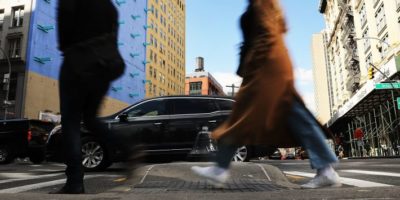
“Traffic safety doesn’t get the attention of many things that kill far fewer people, because we regard that risk as part of everyday life,” says Lila Ralston, project coordinator at the Traffic Safety Research and Evaluation Group at the University of Georgia College of Public Health.
“I can’t think of anything that’s really drastically different in Georgia from the rest of the country,” says Ralston, “I mean most of the trends we are seeing in Georgia match with national trends, mainly a worrying increase in the last eight or nine years.”
She cites distracted drivers and the types of vehicles on the road as factors in the increase in deaths.
“It’s a thousand tiny factors,” Ralston says. “I think there’s an increase, as I said, in people walking or driving . . . looking at the cellphone and handling it, I think there’s the increase of SUVs and light trucks, which are both more dangerous for pedestrians.’’
About a third of pedestrians and one-fifth of drivers involved in pedestrian fatalities are drunk, she adds. “Alcohol is always a concern, but the combination of alcohol with other drugs and the combination of drugs is an increasing factor.”
Some of Ralston’s research also shows a higher number of pedestrian deaths in rural areas, something which has long been known among traffic safety experts.
Ralston believes that pedestrian fatalities are a problem that can be fixed, although not easily. She pointed to Australia, where efforts have brought a sharp decline in the number of pedestrian deaths, which is “an indicator that we’re not doing everything that we could be doing.”
“The innovative approach is something called Vision Zero,” Ralston said. “Vision Zero is the philosophical statement that the acceptable number of traffic fatalities is none, not this number per year, this number per mile, this number per population, but none.”
The Macon-Bibb County’s Pedestrian Safety Review Board is the only group in the state that has adopted Vision Zero so far.
Board Chairman Tom Ellington, who was previously on the Macon City Council, became involved with the group after attending a meeting where he expressed his unhappiness with victim-blaming rhetoric around pedestrian fatalities.
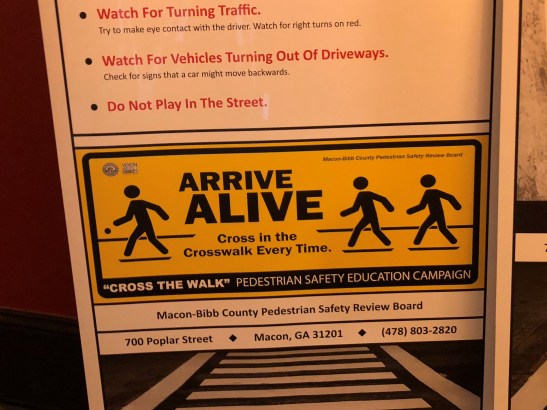
“What had come up was there was people saying there’s always some reason why the pedestrian had played a role, you know, they were wearing dark clothing at night in a poorly lit area, or they weren’t crossing at a crosswalk, or they were drunk or something like that,” he said.
“People wear dark clothing in Columbus, people get drunk in Athens, people cross away from the crosswalk in Atlanta, but they weren’t dying at the same rate as we were seeing in Macon and Bibb, so that tells you that there’s something also wrong with the system and not just with individual behavior.”
Ellington explained that the board works with the Macon-Bibb Board of Commissioners to make sure that sidewalks and safe crossing facilities were placed in projects that the commissioners were approving.
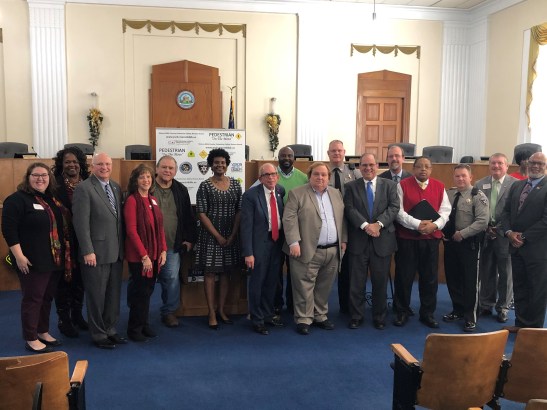
They have also done specific projects, where citizens will tell them about a problem area and they work to come up with solutions and recommendations. There is also an educational facet to the Review Board, teaching people to be safe within the transportation network as it now exists.
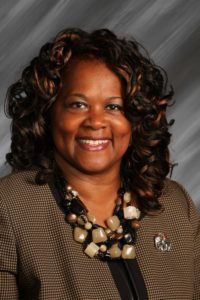
“People are dying and it’s avoidable,” he said. “Every single fatality leaves a void that is never filled. When a pedestrian is hit by a vehicle, you know it’s in the news for a day or two, but that’s somebody who’s not at the table at the holidays. that’s somebody who’s not in people’s lives and people feel that absence. I’ve had this void brought home to me talking to family members of pedestrian fatalities who obviously have a concern here and you can see the pain five, ten, twenty years later. That doesn’t go away.”
Lucas says the board has been a success. “Even though we still have a lot of traffic deaths, we are having an impact on our citizens because we are working with children and folks of all ages to have them consider safety in everything that they do.” Lucas said.
Last year, an old pedestrian death in Macon briefly made national news. Thanks to advances in technology and untiring efforts by investigators, a teenage hitchhiker killed in 1979 while trying to cross I-75 was finally identified as Andrew Greer Jr., who had left his Michigan home a few days before he died.
Athens area tries its own strategy
Besides Macon, another area of the state that is working to improve pedestrian safety is Athens-Clarke County, which implemented a Bicycle and Pedestrian Master Plan in October of last year.
The geographical makeup of the county means that a number of options have to be considered.
“One of the unique things in Clarke County is that it changes contact zones very quickly, so from a dense urban core to kind of urban residential areas to suburban to rural, all very quickly in a matter of miles,” says Drew Raessler, director of the Transportation and Public Works Department at Athens-Clarke County.
“So within each of those contact zones we created a menu of options for what facilities would satisfy the connectivity goals through those zones or we looked at having a number of different bike facilities, pedestrian facilities that could be feasible.”
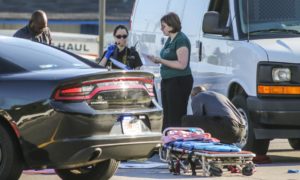
Parts of the master plan include prioritizing areas that have been hot spots for pedestrian crashes and targeting them for near-term improvement, and creating new positions to help implement the changes, according to Raessler.
“We’ve created a bicycle and pedestrian safety coordinator that will be tasked with implementing this plan, implementing some of the educational and encouragement aspects of this plan, as well as looking at safety more broadly and safety for all modes of transportation and developing some actions plans to improve safety,” he said.
“Transportation is something that we all rely on every day, whether it’s walking to a bus stop and getting on a bus or getting in a car or biking to a grocery store, it is something that people depend on and it’s an absolute necessity for everyone directly or indirectly,” Raessler said. “Being able to do that safely improves the lives and well-being of everyone in the community.”
Naomi Thomas is a GHN intern based in Athens

